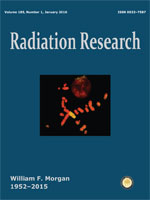Murine small intestinal motility consists of phasic contraction from interstitial cells of Cajal (ICC) and migrating motor complexes (MMCs) from the enteric nervous system. The number of ICC is reduced in various gastrointestinal disorders, and this effect can be reversed once the disorder is resolved through cellular and tissue remodelling. Exposure to high-dose radiation can induce inflammation and alter intestinal motility. In this study, we investigated the changes in the small intestinal motility of 8- to 10-week-old male C3H/HeN mice after high-dose (13 Gy) irradiation. The aim of this study was to determine whether those changes are caused by changes in the ICC or enteric nervous system. After irradiation, the small intestine was dissected and stored in oxygenated Krebs-Ringer bicarbonate solution. The tension of contractions and intracellular membrane potentials were recorded at day 0, 1, 3 and 5 after irradiation and compared with those of sham-irradiated mice. Histological evaluation was performed by immunohistochemistry and apoptosis was evaluated. Quantitative real-time polymerase chain reaction (qPCR) for c-kit mRNA was also performed. Phasic contractions were not changed at day 0, 1, 3 and 5 after irradiation and did not significantly differ from those in the control mice. Slow waves were also sustained after irradiation. However, the frequency of migrating motor complexes (MMCs) was significantly higher at day 0 and 1 after exposure and the amplitude and area under the curve were significantly lower at day 3 after exposure compared with control mice. MMCs were recovered at day 5 with no difference from those of the control mice. ICC were detected after irradiation by immunohistochemistry for c-kit, and c-kit mRNA levels did not differ between sham-irradiated and irradiated mice. Histological evaluation showed that the most severe inflammation was detected at day 3 after irradiation, and apoptosis was detected only in the mucosa. Acetylcholine increased the contractility after irradiation, and tetrodotoxin decreased the number of MMCs in sham-irradiated and irradiated mice. Nw-oxide-l-arginine (L-NA) increased the number of MMCs. MMCs were recovered after L-NA treatment at day 3 after irradiation. Sodium nitroprusside decreased the MMCs in sham-irradiated and irradiated mice. Exposure to high-dose radiation did not alter phasic contractions and slow waves in the small intestine of mice, which suggests that ICC and their functions may be sustained after high-dose irradiation. Mucosal inflammation was severe after irradiation and there were some changes in MMCs related to the enteric nervous system.
How to translate text using browser tools
31 December 2015
High-Dose Radiation-Induced Changes in Murine Small Intestinal Motility: Are the Changes in the Interstitial Cells of Cajal or in the Enteric Nervous System?
Seung-Bum Ryoo,
Joong-Sun Kim,
Min-Seouk Kim,
Kyubo Kim,
Seung A Yu,
Min-Ji Bae,
Heung-Kwon Oh,
Sang Hui Moon,
Eun Kyung Choe,
Insuk So,
Kyu Joo Park
ACCESS THE FULL ARTICLE

Radiation Research
Vol. 185 • No. 1
January 2016
Vol. 185 • No. 1
January 2016




